Elevate your establishing scenes with these 10 stunning drone shots. Capture a sweeping cityscape reveal, soar through mountain passes, and descend coastal cliffs for dramatic impact. Follow winding rivers, emerge from forest canopies, and spiral around architectural marvels. Showcase rural farmland patchworks and urban traffic flows for contrast. Plunge alongside waterfalls for a thrilling perspective. Each shot offers unique angles and storytelling opportunities, from revealing hidden valleys to highlighting seasonal landscape changes. Whether you're filming natural wonders or man-made structures, these aerial techniques will add depth and intrigue to your opening sequences. Explore further to master the art of drone cinematography and transform your productions.
Key Takeaways
- Sweeping cityscape reveals with iconic landmarks provide immediate location identification and urban character.
- Soaring mountain passes showcase vast terrains and create a sense of journey through winding roads.
- Coastal cliff descents contrast rugged landscapes with expansive ocean views for dramatic effect.
- Winding river follows offer dynamic scenery changes while maintaining consistent altitude and speed.
- Desert dune patterns utilize light and shadow interplay to create striking visuals, especially during golden hour.
Sweeping Cityscape Reveal

From high above, a sweeping cityscape reveal can set the stage for your entire film. Start with your drone positioned far above the city's outskirts, capturing the change from rural to urban landscapes. As you slowly move forward, gradually lower the altitude to reveal the city's sprawling expanse.
Focus on iconic landmarks or recognizable features that immediately identify the location. Tilt the camera downward slightly to showcase the urban grid and bustling streets below. Vary your speed, starting slow and gradually increasing as you approach the heart of the city.
Consider the time of day for your shot. Golden hour lighting can cast dramatic shadows and warm hues across skyscrapers, while a nighttime approach can highlight twinkling lights and neon signs. Use smooth, fluid movements to create a sense of majesty and scale.
Don't forget to capture the city's unique character. Whether it's winding canals, historic architecture, or modern skylines, emphasize elements that make the location distinct.
End your reveal by focusing on a specific area or building relevant to your story, seamlessly shifting into your next scene.
Soaring Mountain Pass
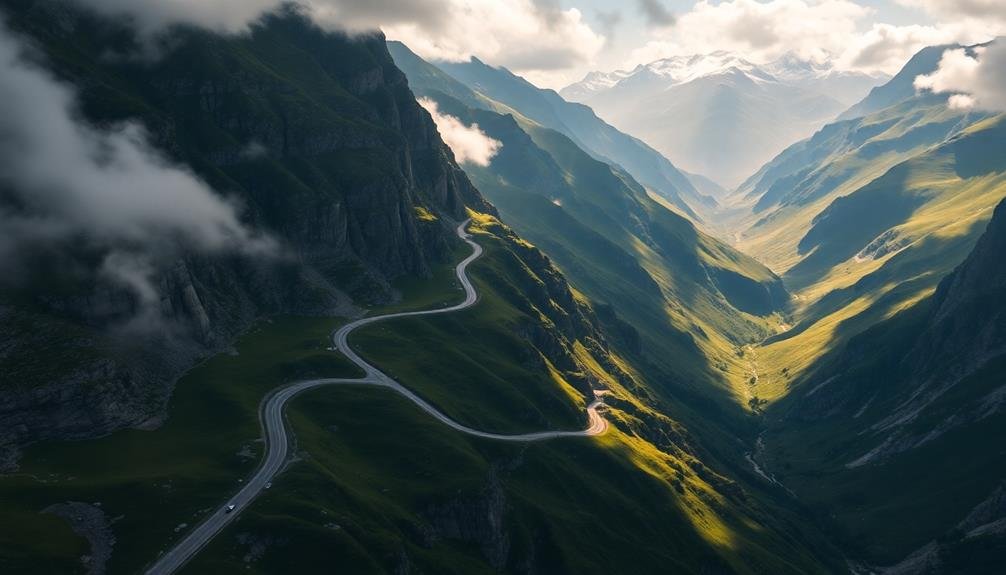
When filming a soaring mountain pass, you'll want to capture the dramatic elevation changes that showcase the landscape's grandeur.
You can achieve this by following winding mountain roads with your drone, creating a sense of journey and anticipation.
As you navigate the pass, reveal hidden valleys below to add an element of surprise and showcase the breathtaking scale of the mountainous terrain.
Capturing Dramatic Elevation Changes
Drone cinematography really comes into its own when capturing dramatic elevation changes like a soaring mountain pass. To showcase these breathtaking landscapes, you'll want to master a few key techniques.
Start with a slow, steady ascent from the base of the mountain, allowing viewers to grasp the scale of the terrain. As you rise, gradually increase your speed to create a sense of exhilaration.
Experiment with different flight paths to maximize the impact. Try flying parallel to the mountain's face, revealing its contours and craggy features. Then, sweep across the ridge line to emphasize the sheer drop on either side.
For a truly awe-inspiring shot, position your drone at the pass's narrowest point and fly through it, capturing the way the landscape opens up on the other side.
Don't forget to play with perspective. Alternate between wide, sweeping shots that showcase the entire mountain range and tighter frames that highlight specific features like jagged peaks or winding roads.
Following Winding Mountain Roads
Winding mountain roads offer some of the most enchanting aerial shots for establishing scenes. As you guide your drone along these serpentine paths, you'll capture the raw beauty of nature intertwined with human engineering.
Start your shot from a high vantage point, revealing the entire stretch of road cutting through the landscape. Then, gradually descend and follow the road's curves, mimicking a car's journey.
To create stunning visuals, focus on:
- Contrasting the road's smooth lines against rugged terrain
- Showcasing hairpin turns and switchbacks from above
- Capturing the interplay of light and shadow as the road weaves through valleys
- Revealing hidden vistas and viewpoints along the route
As you film, vary your drone's speed to match the road's rhythm. Slow down for tight turns and speed up on straightaways.
Don't forget to include elements that give scale, such as cars or lookout points. By following the road's natural flow, you'll create a sense of movement and anticipation, perfect for establishing the setting of a mountain adventure or road trip story.
Revealing Hidden Valleys Below
A soaring mountain pass offers a unique opportunity to disclose hidden valleys below, creating a breathtaking establishing shot. As you pilot your drone over the ridge, position it to capture the vast expanse of the valley floor gradually coming into view.
Start with the camera tilted slightly upward, focusing on the rugged mountain peaks. Then, slowly tilt the camera downward as you fly forward, revealing the landscape below.
To maximize the impact, time your shot during the golden hour when long shadows accentuate the terrain's contours. Use a slow, steady movement to build anticipation and allow viewers to absorb the scene's magnitude.
Consider incorporating natural elements like mist or low-hanging clouds to add depth and mystery to the disclosure.
Experiment with different altitudes to find the perfect balance between showcasing the valley's scale and capturing intricate details. A higher altitude will emphasize the vastness, while a lower flight path can highlight interesting features like winding rivers or patchwork fields.
Remember to maintain a safe distance from any obstacles and respect local drone regulations. This powerful establishing shot will set the stage for your story, immersing viewers in the awe-inspiring landscape.
Coastal Cliff Descent
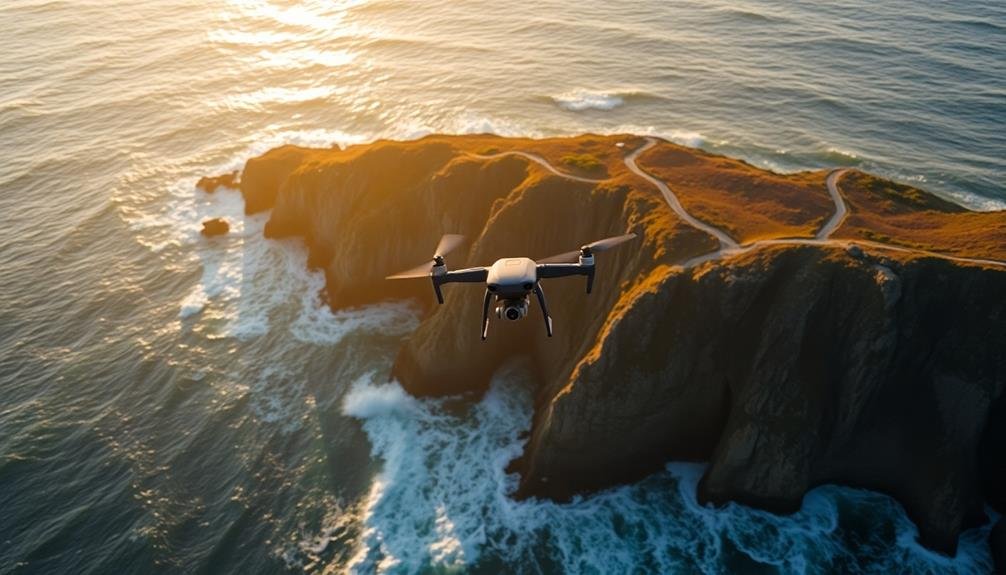
You'll create a breathtaking coastal cliff descent shot by starting high above the shoreline and gradually lowering your drone.
As you descend, you'll reveal the dramatic landscape, showcasing the sheer scale of the cliffs against the vastness of the ocean.
Follow the natural contours of the coastline to add depth and perspective, allowing viewers to experience the rugged beauty of the seaside terrain.
Dramatic Landscape Reveal
Along the rugged coastline, a dramatic landscape disclosure unfolds as your drone descends from high above a coastal cliff. This shot captivates viewers by gradually disclosing the breathtaking scenery below.
As you guide your drone downward, the vast expanse of the ocean comes into view, contrasting sharply with the rugged terrain.
To create a truly memorable dramatic landscape disclosure, focus on these key elements:
- Start with a bird's-eye view of the cliff's edge, showing its jagged contours against the horizon.
- Slowly tilt the camera downward as the drone descends, revealing the sheer drop and crashing waves below.
- Pan the shot to showcase the coastline's features, such as hidden coves, sea stacks, or beaches.
- End with a sweeping motion that captures both the cliff face and the expansive ocean view.
Scale and Perspective
As your drone descends along the coastal cliff, it's vital to capture the immense scale and unique perspective this vantage point offers. Start with a wide shot at the top, showcasing the entire coastline and the vast ocean beyond.
As you move downward, gradually tighten your frame to highlight the cliff's vertical drop and rugged texture. Pay attention to any interesting geological features or patterns in the rock face. Capture the contrast between the solid cliff and the churning waves below.
If there are seabirds nesting or flying around, include them to add a sense of life and movement to your shot. Near the bottom, focus on the intersection of land and sea. Capture the spray of waves crashing against the cliff base, emphasizing the power of nature.
If possible, include a recognizable object like a boat or a person on the beach to provide a clear sense of scale. Throughout the descent, maintain a smooth and steady movement to create a cinematic feel.
Experiment with different angles and speeds to find the most visually striking composition that best conveys the cliff's imposing presence and the surrounding environment's beauty.
Following Coastal Contours
Following coastal contours offers a unique opportunity to showcase the dynamic interplay between land and sea. As you guide your drone along the shoreline, you'll capture breathtaking visuals that highlight the raw beauty of coastal landscapes.
Start with a wide establishing shot, then gradually descend as you follow the cliff's edge, revealing intricate details and textures.
To create stunning coastal contour shots, focus on these key elements:
- Contrast between rugged cliffs and smooth water surfaces
- Patterns formed by waves crashing against rocky outcrops
- Interplay of light and shadow on cliff faces
- Natural formations like sea stacks, arches, or caves
As you descend, vary your speed to add drama and emphasize specific features. Slow down when approaching particularly interesting formations or when capturing the motion of waves.
You can also incorporate subtle camera movements, such as gentle pans or tilts, to enhance the sense of scale and depth.
Remember to maintain a safe distance from the cliffs and be aware of potential obstacles or wildlife.
Winding River Follow

The drone glides effortlessly over and around a winding river, capturing its serpentine path through the landscape. You'll find this shot particularly effective for establishing scenes in rural or wilderness settings. As you follow the river's course, you're revealing the surrounding terrain and creating a sense of journey for your audience.
To execute this shot effectively, maintain a consistent altitude and speed. This allows viewers to focus on the changing scenery rather than abrupt camera movements. You can add visual interest by gradually descending as you progress along the river, bringing the audience closer to the water's surface.
Consider these factors when planning your winding river follow shot:
| Aspect | Considerations | Tips |
|---|---|---|
| Time of Day | Golden hour for best lighting | Avoid harsh midday sun |
| Season | Foliage changes, water levels | Plan for desired aesthetic |
| Weather | Clear skies vs. cloudy | Use conditions creatively |
Remember to scout your location beforehand, ensuring you're aware of any obstacles or restricted airspace. By mastering this technique, you'll add a dynamic and visually engaging element to your establishing scenes, drawing viewers into your story's setting.
Forest Canopy Emergence
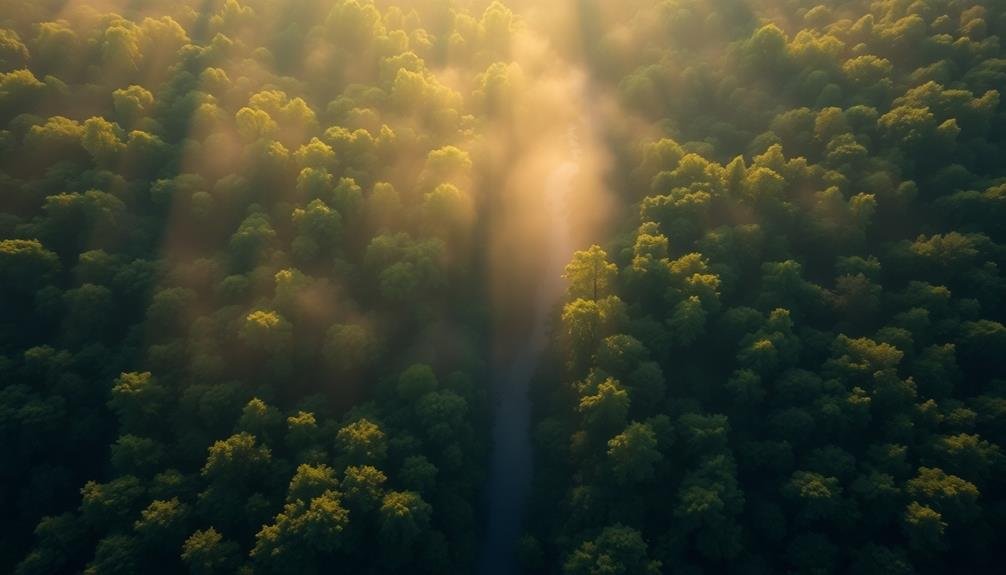
Emergence from a forest canopy creates an enchanting establishing shot that's sure to wow your audience. As your drone rises above the treetops, you'll reveal a breathtaking expanse of green that evolves into the wider landscape. This shot works particularly well in densely forested areas, where the sudden reveal of what lies beyond creates a dramatic contrast.
To execute this shot effectively, start with your drone hovering just below the canopy level. Slowly ascend, allowing the camera to capture the gradual reveal of the forest's true scale. As you break through the uppermost branches, adjust your camera angle to showcase the vastness of the forest and its surroundings.
To create vivid imagery in your audience's mind, consider these elements:
- Sunlight filtering through leaves and branches
- Mist rising from the forest floor
- Birds taking flight as the drone emerges
- A distant mountain range or body of water coming into view
Experiment with different times of day and weather conditions to add variety to your forest canopy emergence shots. Dawn and dusk can provide particularly stunning lighting effects, while overcast days may create a moody, atmospheric feel.
Desert Dune Patterns
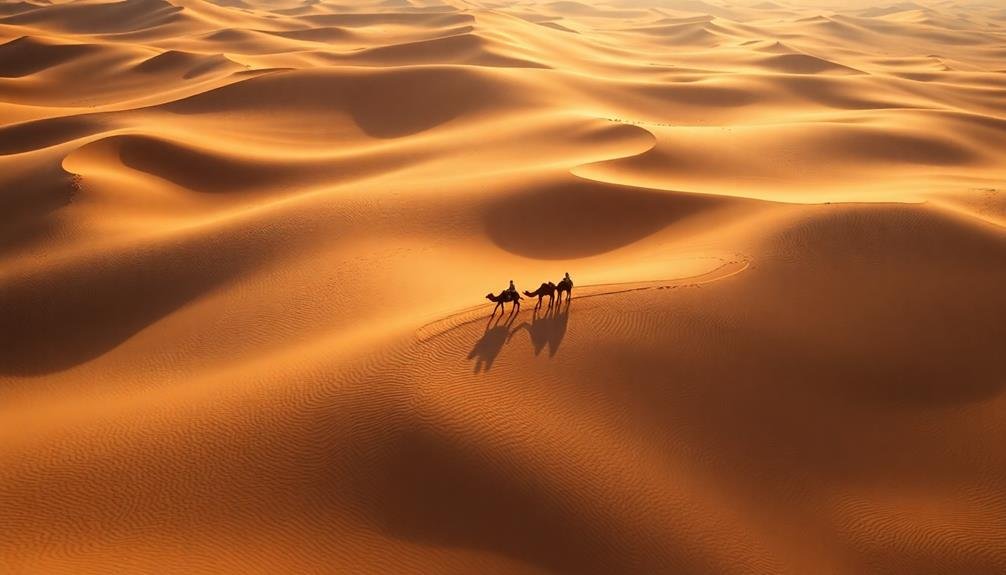
Desert dunes' mesmerizing patterns offer a stunning canvas for aerial cinematography. You'll find that capturing these intricate formations from above can create visually striking establishing shots for your film or video project. To enhance the impact of your desert drone footage, focus on the interplay of light and shadow across the dunes.
Consider filming during golden hour for warm, dramatic lighting that accentuates the curves and ripples in the sand. You'll want to experiment with different altitudes to showcase both the vastness of the desert landscape and the intricate details of individual dunes. Try incorporating movement in your shots by slowly panning or flying low over the dunes to create a sense of scale and drama.
Here's a quick guide to ideal drone settings for desert dune shots:
| Time of Day | Altitude | Camera Angle | Flight Mode |
|---|---|---|---|
| Sunrise | 100-200ft | 45° down | Orbit |
| Midday | 300-500ft | Straight down | Waypoint |
| Sunset | 50-100ft | 30° down | Manual |
| Night | 200-400ft | Straight down | Tripod |
Remember to adjust your camera's exposure settings to account for the bright, reflective nature of sand. By mastering these techniques, you'll capture breathtaking desert dune patterns that elevate your establishing scenes.
Architectural Spiral Ascent

Moving from natural landscapes to man-made marvels, architectural spiral ascents offer a fascinating subject for drone cinematography. These sweeping shots showcase the beauty of human engineering while creating visually stunning sequences. You'll want to capture the building's unique shape and the way it interacts with its surroundings.
To nail this shot, start your drone at ground level and slowly ascend, following the building's spiral structure. As you rise, keep the camera focused on the building's facade, revealing intricate details and patterns. You'll create a mesmerizing effect that draws viewers into the scene and establishes the location's grandeur.
Consider these elements to enhance your architectural spiral ascent shots:
- Time of day: Golden hour lighting can add warmth and depth to the building's texture
- Weather conditions: Partly cloudy skies create interesting shadow play on the structure
- Surrounding environment: Include nearby landmarks or skyline for context
- Camera movement: Combine ascent with a slow rotation for a more dynamic shot
Remember to maintain a safe distance from the building and respect local drone regulations. With practice, you'll master this technique and add a powerful tool to your establishing shot repertoire.
Rural Farmland Patchwork
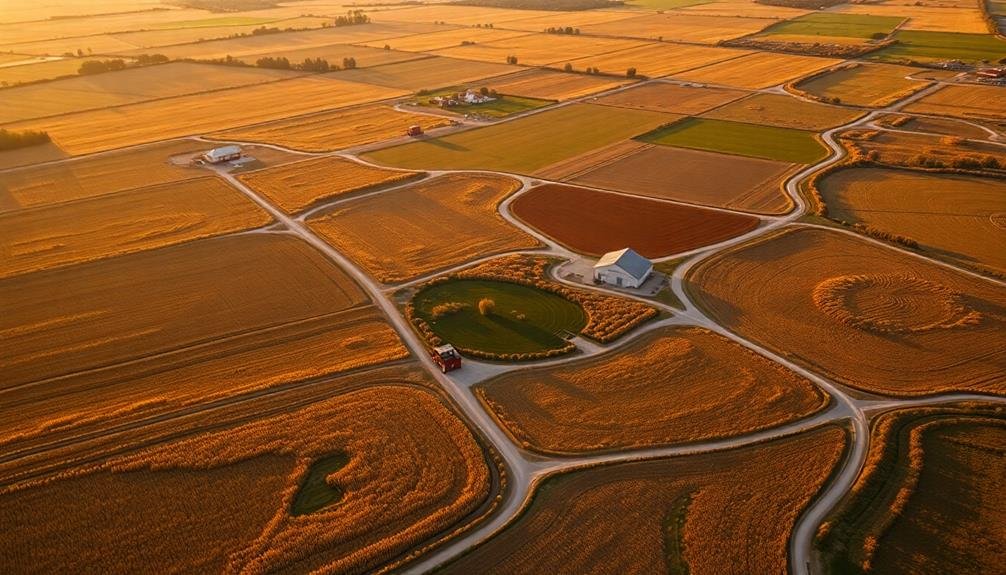
You'll find rural farmland patchwork shots offer a striking visual tapestry from above.
Capture the geometric field patterns created by different crops and farming practices, showcasing the stark contrasts and symmetry.
Don't miss the opportunity to highlight seasonal color changes or catch farming equipment in action, adding movement and scale to your aerial compositions.
Geometric Field Patterns
When capturing geometric field patterns from above, you'll discover a mesmerizing patchwork of rural farmland. These aerial shots showcase the intricate designs created by different crops, irrigation systems, and farming techniques.
As you fly your drone over these landscapes, you'll be amazed by the striking contrasts and symmetry that emerge.
To capture the most enthralling geometric field patterns, focus on:
- Circular pivot irrigation systems creating perfect circles and semicircles
- Rectangular fields with alternating crop types, forming a checkerboard effect
- Curved terraces following the natural contours of hillsides
- Triangular sections created by intersecting roads or property lines
Experiment with different altitudes to find the sweet spot that best highlights the patterns.
Early morning or late afternoon light can enhance shadows and textures, making the geometric shapes more pronounced.
Don't forget to adjust your camera settings to capture the vibrant colors of various crops and soil types.
Seasonal Color Changes
Seasonal color changes transform rural farmland into a vibrant, ever-evolving canvas for drone photographers. You'll find endless opportunities to capture stunning aerial shots as the landscape shifts through the year.
In spring, focus on the bright greens of emerging crops and the patchwork of freshly tilled soil. Summer brings a rich tapestry of golden wheat fields contrasting with lush green cornfields and vibrant wildflower meadows.
As autumn approaches, you'll want to highlight the warm hues of changing leaves in nearby woodlands alongside harvested fields. Capture the contrast between amber cornfields ready for harvest and the deep greens of late-season crops.
Winter offers a unique perspective, with snow-covered fields creating a stark, minimalist landscape punctuated by bare trees and isolated farmhouses.
To maximize the impact of seasonal changes, plan your flights during the golden hours of sunrise or sunset. The low-angled light will enhance the colors and textures of the rural patchwork.
Consider using time-lapse techniques to showcase the gradual transformation of specific areas throughout the year, creating a compelling visual narrative of the changing seasons in rural landscapes.
Farming Equipment in Action
Drone photography's dynamic potential truly shines when capturing farming equipment in action across rural landscapes. You'll find that these shots offer a unique perspective on the intricate dance of agriculture, showcasing the scale and efficiency of modern farming practices.
When framing your shots, focus on the contrast between the mechanical precision of the equipment and the organic patterns of the fields. Capture combines harvesting golden wheat, tractors plowing rich earth, or irrigation systems creating circular oases in arid landscapes. These images tell a compelling story of human ingenuity and nature's bounty.
To create striking visuals, consider these elements:
- Dramatic lighting during golden hour to highlight dust clouds and metallic surfaces
- Symmetrical compositions emphasizing the geometric patterns of crop rows
- Juxtaposition of tiny human figures against massive machinery
- Follow shots that track equipment movement, revealing the transformation of the land
Urban Traffic Flow
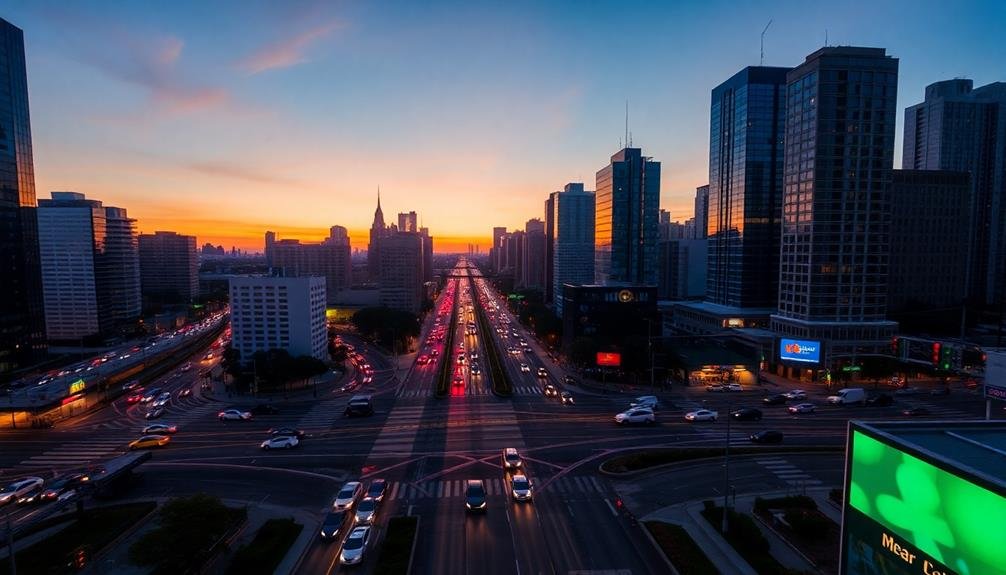
Chaos transforms into a mesmerizing dance when viewed from above. That's exactly what you'll capture when filming urban traffic flow with your drone. You'll want to position your drone high enough to showcase the intricate patterns of vehicles moving through city streets, highways, and intersections.
Start by finding a busy intersection or highway interchange. Shoot during rush hour for maximum impact, capturing the ebb and flow of traffic as lights change and cars merge. You'll see mesmerizing patterns emerge as vehicles weave in and out of lanes.
Don't forget to include landmarks or recognizable city features to provide context. A bird's-eye view of cars circling a famous roundabout or streaming across an iconic bridge can be visually stunning.
Experiment with different times of day. Early morning or late evening shots can showcase the streams of headlights and taillights, creating rivers of light through the urban landscape. For a unique perspective, try capturing the shift from day to night in a time-lapse sequence.
Remember to follow local drone regulations and prioritize safety when filming in urban areas.
Waterfall Plunge
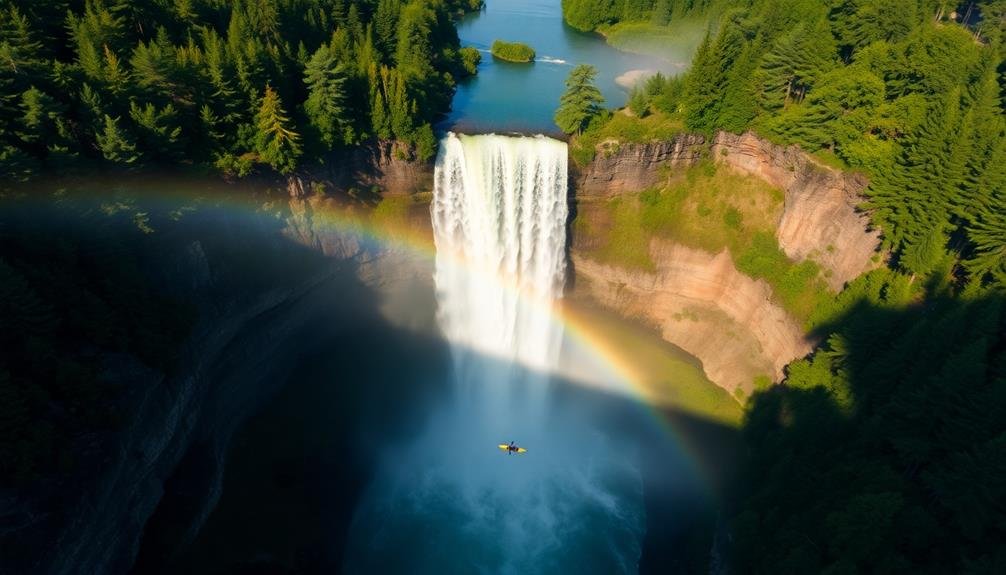
From towering heights to misty depths, capturing a waterfall plunge with your drone offers a breathtaking perspective on nature's raw power. You'll want to showcase the waterfall's full scale, from its origin point to the churning pool below. Start with a wide shot, gradually descending to reveal the waterfall's magnitude. As you fly closer, capture the water's texture and the mist it creates, adding depth to your scene.
For the most enchanting waterfall plunge shots, consider these techniques:
- Fly your drone parallel to the falling water, creating a sense of vertigo and emphasizing the height.
- Capture a top-down view of the impact zone, highlighting the circular patterns and foam created by the plunging water.
- Use a slow, steady ascent from the base to the top, revealing the waterfall's full length and surrounding landscape.
- Incorporate nearby elements like rocks, trees, or wildlife to provide scale and context.
Remember to adjust your camera settings for the high-contrast scene. Use a faster shutter speed to freeze water droplets and maintain sharpness.
Be mindful of local regulations and environmental impact when flying near waterfalls. With these techniques, you'll create stunning establishing shots that immerse your audience in the scene's natural beauty and power.
Frequently Asked Questions
What Drone Regulations Should I Be Aware of Before Filming?
You'll need to register your drone with the FAA if it weighs over 0.55 lbs. Follow local laws, don't fly near airports or crowds, stay below 400 feet, and always keep your drone in sight.
How Do Weather Conditions Affect Drone Cinematography?
Weather greatly impacts your drone filming. Wind can destabilize shots, while rain damages equipment. Sunlight affects exposure and creates shadows. Clouds can add drama or flatten light. You'll need to adapt your techniques for different conditions.
What Are the Best Drones for Cinematic Shots on a Budget?
You'll find great budget options in the DJI Mini series or Autel Evo Nano. They're lightweight, offer 4K video, and have decent flight times. Don't forget to reflect on refurbished models for even better deals.
How Can I Improve My Drone Piloting Skills for Smoother Footage?
You'll improve your drone piloting skills by practicing regularly. Start with basic maneuvers in open spaces. Use simulator apps to hone your skills safely. Gradually increase complexity and try different flight modes for smoother footage.
What Post-Processing Techniques Enhance Drone Footage in Editing?
You'll enhance your drone footage in editing by stabilizing shaky clips, color grading for a cinematic look, adjusting exposure and contrast, applying subtle slow-motion effects, and using warp stabilizer for smoother movement. Don't forget to trim unnecessary parts.
In Summary
You've now got 10 powerful drone shots in your arsenal to take your establishing scenes to new heights. Whether you're showcasing urban landscapes, natural wonders, or architectural marvels, these techniques will captivate your audience from the start. Remember to practice and experiment with each shot, adapting them to your unique locations and storytelling needs. With these aerial perspectives, you'll create unforgettable openings that set the stage for your entire production. Happy flying!

As educators and advocates for responsible drone use, we’re committed to sharing our knowledge and expertise with aspiring aerial photographers.
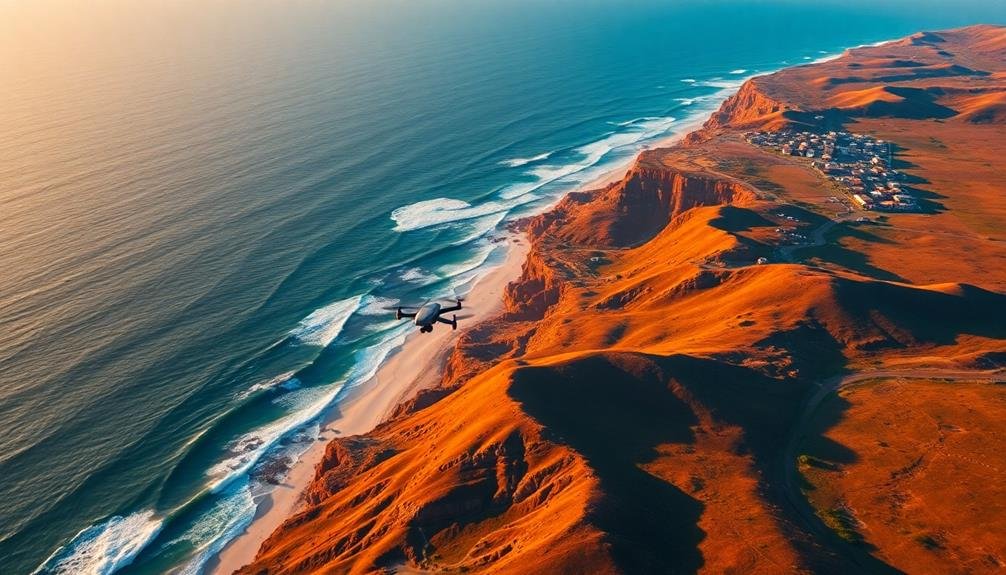



Leave a Reply